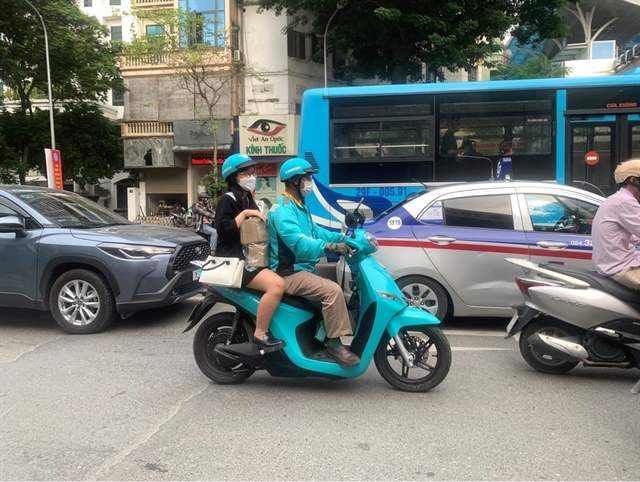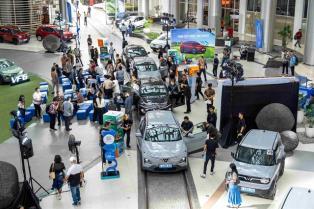While charging an e-bike battery takes six to eight hours, swapping takes less than two minutes, making electricity battery swapping market potential.

HÀ NỘI — A wave of investment is surging into battery-swapping stations for electric two-wheelers as Việt Nam pushes towards green mobility, creating a multi-billion-dollar market.
Most recently, South Korea’s LG Energy Solution (LG ENSOL) in early October worked with Hà Nội’s authorities on the project of developing a battery-swapping network for electric motorbikes in the capital city.
A representative from LG ENSOL said that the project aims to supply batteries for about 100,000 users, or 100,000 e-scooters, in the capital city. The station will feature AI-powered virtual assistances and an integrated operation system managed from a control centre at Hoà Lạc Hi-Tech Park.
Once the network reaches a certain scale, LG ENSOL plans to build a factory in Hà Nội to produce batteries and related components for the swapping systems.
Other players are rushing in, too.
Selex Smart Electric Vehicle Joint Stock Company (Selex Motors), a logistics and e-mobility solutions provider, already joined in the race. CEO of Selex Motor Nguyễn Hữu Phước Nguyên said that the company plans to have 300 swapping cabinets nationwide by 2026 and increase to 3,000 by 2028. It currently charges VNĐ8,000 (US$0.3) per swap.
In July, TMT-EGREEN, a subsidiary of TMT Motors, announced plans to roll out battery swapping stations nationwide. Each cabinet can hold from 5 to 72 batteries and operates on 220V household electricity, allowing swaps in just one to two minutes.
Honda Vietnam has also launched battery-swapping services for its CUV e model through 19 authorised dealers in Hà Nội, HCM City and Đà Nẵng and offered free swaps for rental customers.
V-Green, a charging infrastructure developer under Vingroup, is pushing for an aggressive rollout which aimed to install hundreds of charging and swapping points on sidewalks in Hà Nội and HCM City in the fourth quarter of this year.
CEO of V-Green Nguyễn Thành Dương said that the company has partnered with local retail giants to use part of their commercial space for setting up stations.
V-Green targets 150,000 swapping cabinets nationwide to meet the growing demand for its Vinfast scooters. It would take only 10-20 seconds for each swapping, the company said.
V-Green estimated that Việt Nam would need around 300 million battery units and 500,000 swapping cabinets if all 80 million petrol-fueled motorbikes were replaced by electric vehicles, which requires huge investments, given an average cost of $200 per battery and $500 per cabinet.
V-Green planned to raise private investment through a franchise model for charging and swapping stations to reduce the financial burden.
Huge potential

Charging infrastructure and speed are considered decisive factors in Việt Nam’s push toward transport electrification, according to a joint survey by Chợ Tốt Xe and KMPG.
While charging an e-bike battery takes six to eight hours, swapping takes less than two minutes, highlighting the potential of the electricity battery swapping market.
According to market research firm Mordor Intelligence, Southeast Asia’s battery-swapping market will reach $710 million by 2025 and $3.03 billion by 2030, with an annual growth rate of 34.6 per cent.
Plans to develop low-emission zones (LEZs) are also driving demand for switching to electric vehicles, and for charging and swapping stations.
A LEZ is proposed to be developed in the central area of HCM City starting from 2026, which will restrict petrol and diesel vehicles that fail to meet emission standards.
To encourage switching from petrol to electric vehicles, subsidies covering up to VNĐ20 million are proposed for buyers of electric motorbikes.
Incentive policies, including tax and fee reductions as well as interest subsidies, are also proposed for buyers and transport companies switching to electric vehicles.
The southern city’s project of replacing about 400,000 petrol motorbikes used by ride-hailing and delivery drivers with electric models within the next three years also provides room for charging and swapping system development.
According to the proposed project, HCM City needs to establish 3,000 public charging and battery swapping points by the end of 2028, five times higher than the current number.
The city’s current charging and swapping system could meet only 10 per cent of the demand in 2028, Antoine Goupille from RMIT University Việt Nam said.
Battery swapping is a better choice for ride-hailing and delivery drivers because it saves time, she said.
Hà Nội is also pushing for a LEZ which will restrict diesel vehicles.
The capital city is developing a roadmap for the transition from petrol to electric transport, with priority on public vehicles first, Deputy Chairman of the municipal People’s Committee Nguyễn Mạnh Quyền said.
By 2030, Hà Nội plans to replace nearly 3,000 buses and 24,000 taxis with clean-fuel vehicles. For motorbikes, the city will promote the shift from petrol to electric models, with a focus on expanding charging and swapping infrastructure to support the transition.
The shift from petrol to electric vehicles will require synchronised development of charging infrastructure, Phạm Bình An, deputy director of the HCM City Institute for Development Studies, said.
He said that the Government would play a role in guiding transport electrification with more drastic actions, such as financial tools to encourage the transition.
Statistics from Motorcycles Data show that more than 209,000 electric scooters were sold in Việt Nam in the first half of this year, ranking third globally in terms of electric motorbike purchases, trailing only China and India. — VNS





